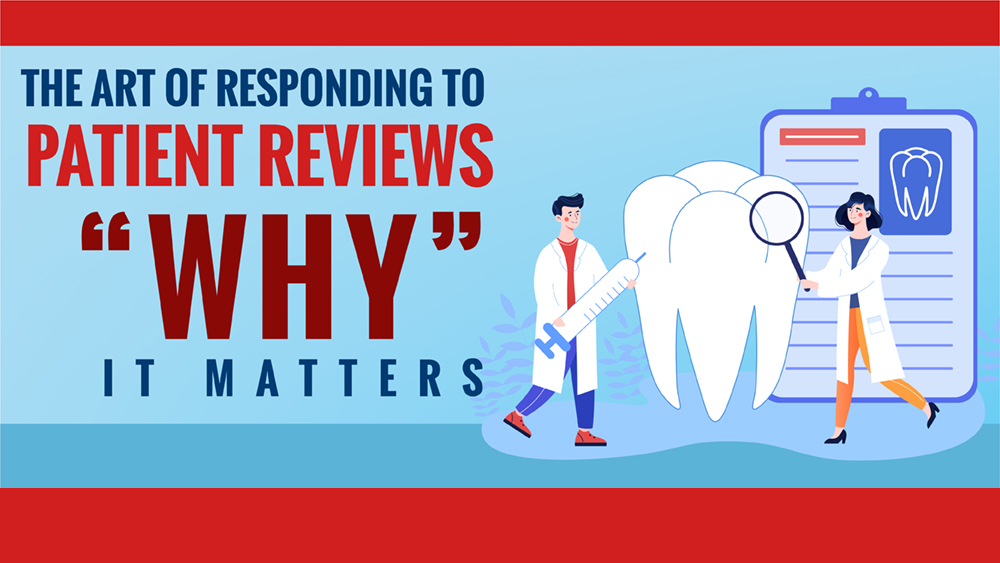Adult patients present with defined treatment goals and priorities. While some of them would like a full mouth rehabilitation, often their goals are more discrete and specific, looking to fix “just the one thing” that brought them into the office. As health care providers, we have to balance the patient’s wishes with their oral health interests and educate them about options, advantages, disadvantages, risks and benefits of the options in front of them. Adults will prioritize speed, cost and esthetics of treatment, and the hierarchy of those depends on the individual.1 Fortunately, in modern dentistry and orthodontics we have many tools to help our patients achieve their goals.
Orthodontists work closely with general dentists, prosthodontists, periodontists and oral surgeons to re-establish esthetics, proper occlusion, and replace missing teeth. Due to the esthetic demands of many of our adult patients, we use esthetic orthodontic tools to achieve our goals: these appliances include clear labial braces, clear aligners such as Invisalign, and lingual braces. The main differences between a fixed appliance (braces) and removable aligners can be seen in Table 1. This article will discuss the main reasons patients seek pre-prosthetic orthodontics (Table 2) and will review advantages and disadvantages of fixed or removable orthodontic appliances in treating various malocclusions.
Table 1

Table 2

Which appliance is best?
The answer to this depends on the skill and experience of the provider, as well as the clinical situation. There is no inherent “magic” in a bracket or in a clear aligner, just like there is no “magic” in a handpiece or surgical instrument: the outcome is directly related to the skill of the provider doing the treatment and the biology of the patient.
Table 3 describes some general guidelines to aid with appliance selection depending on the clinical situation. While most patients are successfully treated with one appliance, for some patients a multi-appliance approach can lead to the optimal clinical outcome. That may mean a short course of braces to accomplish some movements (ex. complex root movement) followed by aligners to complete other movements. Even the most esthetically conscious patient will usually accept a short course of fixed appliances if that is what will lead them to the best result!
Table 3

A review of the main reasons for seeking pre-prosthetic orthodontics and advantages and disadvantages of fixed and removable orthodontic appliances is discussed below.
Pre-prosthetic goal 1: Opening space for missing teeth
When patients present with missing teeth that the orthodontist must make room for, the first consideration when it comes to appliance selection is “how much root movement is required to reopen the space?”. If a significant amount of bodily root movement is required, a fixed appliance such as braces is favourable; if more tipping movement is required, aligners or braces can be used. Other considerations include rotational movements required, how deep the patient’s bite is and whether it is an anterior or posterior tooth. Refer to Table 3 for strengths and limitations of fixed and removable orthodontic appliances.
An example below of two patients with missing laterals illustrates the difference between cases that are favourable for treatment with fixed appliances and removable appliances. The first patient is missing the 12, 22 and the goal was to distalize the 13 and 23 into their proper position (after sectioning the bridge in the second quadrant) so that implants could be placed at 12, 22. Due to the amount of bodily movement that 13 and 23 had to undergo and the need for root divergence, braces were favourable for this patient.
In the second patient, the roots of the 13, 11, 21, 23 needed to be tipped away from the edentulous sites at 12, 22 with minimal translational movement required. This clinical situation was more favourable to aligners, and that was what was used to re-open the space for implants at 12, 22.
Fig. 1

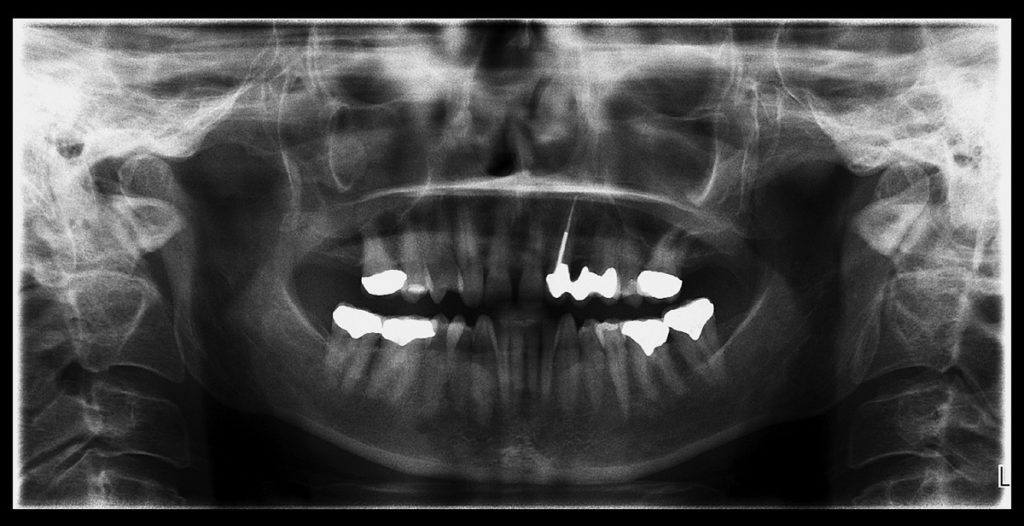
Fig. 2
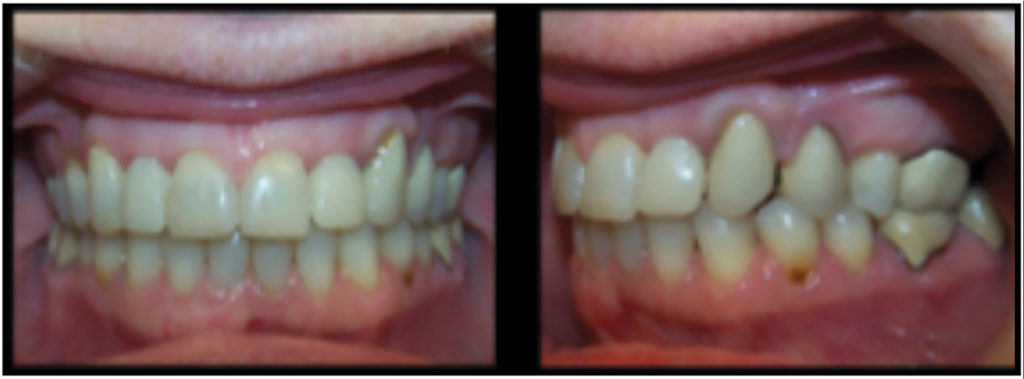
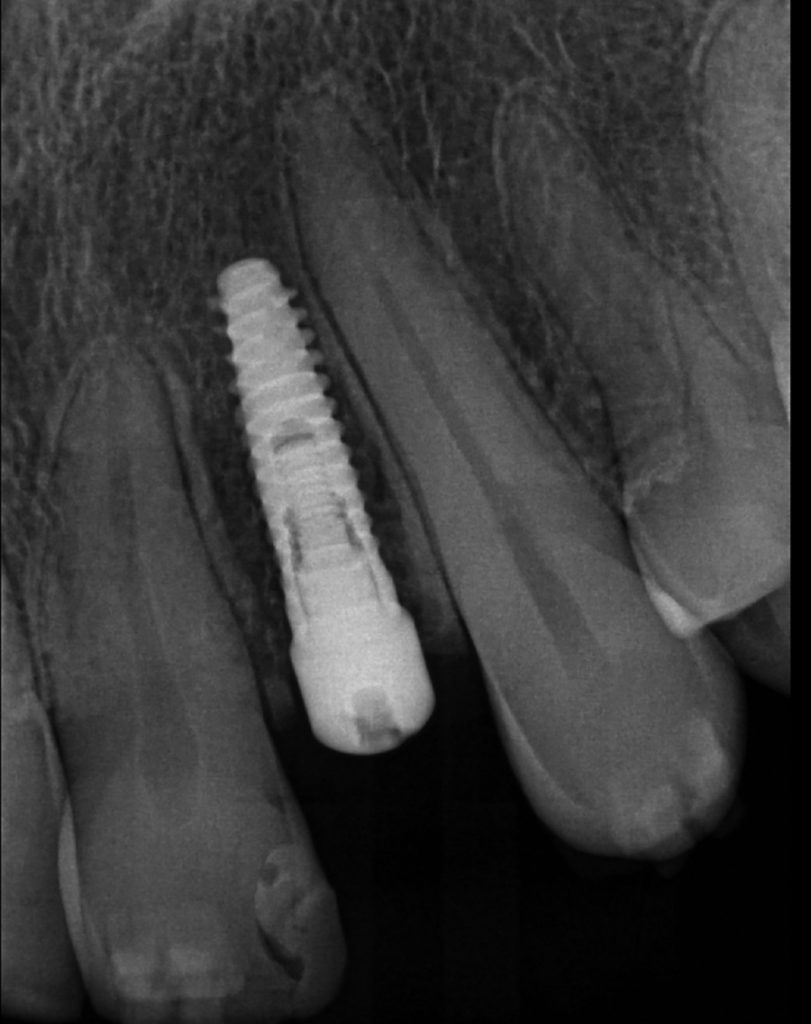
Fig. 3

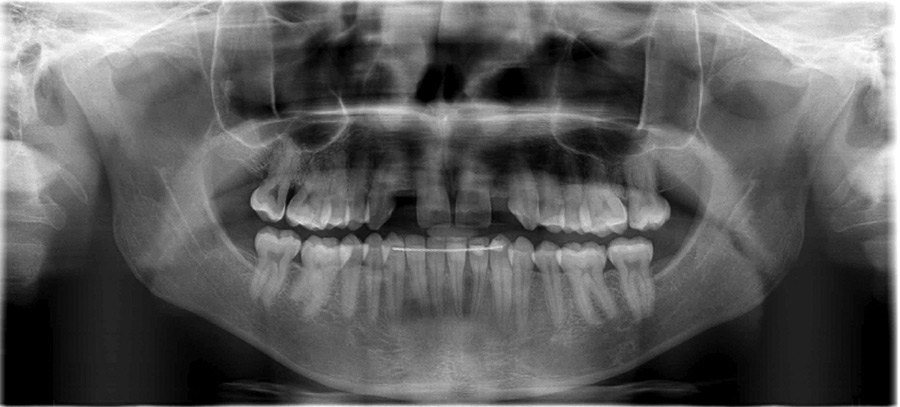
Fig. 4


Pre-prosthetic goal 2: Idealize space around small or misshapen teeth
Many patients have small or misshapen teeth, especially lateral incisors. The role of an orthodontist is to create the ideal amount of space around the teeth so that they can be restored to ideal esthetic and symmetrical proportions.2 To create the appropriate amount of space around these teeth, often braces or aligners can be used due to the movements required.
Pre-prosthetic goal 3: Remove traumatic occlusion to enable restorations ex. deep bites
Worn incisal edges is a very common presentation in today’s patient population. Prior to restoring the lost tooth structure, an examination of the etiology is beneficial in preventing relapse. If it is due to a deep bite, this should be addressed prior to the restorations otherwise their long-term prognosis will be compromised.2 If a patient’s bite should be opened pre-prosthetically, the orthodontist should ask the following questions prior to selecting an appliance:
1. How much bite opening is required?
2. Is it a single tooth or whole segment that requires intrusion?
3. What is the etiology of the deep bite? (i.e. skeletal or dental).
Deep bites of a skeletal etiology with more bite opening required of multiple segments are more favourable for fixed appliances. Less severe bite opening of a dental etiology, with fewer teeth requiring intrusion is more favourable for aligners, or fixed appliances can also be used. An example of two patients who required bite opening prior to restoration of their lost incisal edges demonstrates the strengths and limitations of braces and aligners in deep bite correction.
The first patient had severe attrition, requiring extensive prosthetic reconstruction of maxillary and mandibular incisors. Due to the skeletal deep bite and amount of bite opening required, braces were used to open his bite.
In the second patient, the dentist requested that the patient have less overbite and less overjet in the anterior so that the lost incisal edges could be restored. The bite opening (intrusion) and tipping movements were completed with aligners. Since bite opening is more difficult with aligners, one must build over-correction into the plan and anticipate that the clinical bite opening will be less than is digitally projected.
Fig. 5

restorations placed following treatment to regain lost tooth structure.
Fig. 6

Fig. 7

Fig. 8

Fig. 9

Pre-prosthetic goal 4: Level gingival margins
Similar to intruding teeth to open a deep bite pre-prosthetically, an evaluation of the etiology of the need for gingival margin leveling must be done prior to treatment.3 The orthodontist must identify:
1. How much intrusion is required
2. Whether a whole segment needs to be intruded, or an individual tooth
3. The etiology of the uneven gingival display – skeletal, periodontal, or dental
If the problem is skeletal in nature, the patient may need orthognathic or periodontal surgery as an adjunctive procedure to orthodontics. If a whole segment needs to be intruded to level the gingival margins, fixed appliances may be favourable.
If a single tooth or smaller segment requires intrusion, braces or aligners can be used. Recall that aligners are a pushing appliance, therefore they can be very effective at intruding a tooth or group of teeth if properly designed.
An example of two patients who needed their gingival margins leveled prior to receiving their restorations is seen below. The first patient had a cant to their maxillary occlusion and required the entire second quadrant to be intruded, so braces were favourable. He also received bonding after orthodontics to address the tapered incisors, therefore interdental spaces were left for the restorations.
The second patient required intrusion of the 21 so that the gingival margin was even to the 11 prior to receiving crowns on both the 11 and 21. For this patient, aligners were used and effectively leveled the margins. Since intrusion was required in a limited segment, aligners were an effective tool to accomplish this goal.
Fig. 10

Fig. 11

Fig. 12

Fig. 13

Fig. 14

Pre-prosthetic goal 5: Extrusion of teeth
There are times where a tooth must be extruded pre-prosthetically. One of the most common examples of this is if there is minimal bone for an implant and orthodontic extrusion will increase the bone height or level the gingival margins for the implant. In this treatment, the tooth is deemed hopeless, but before it is extracted it is used to bring the periodontal tissues with it to make the site more favourable for an implant4 (Fig. 16). Another common application of orthodontic extrusion is “orthodontic crown lengthening”, when extrusion is done rapidly so that the periodontal tissues do not follow the tooth.
There are a few important points of note for this type of treatment. The first is that fixed appliances are more favourable than aligners for orthodontic extrusion. Recall that aligners are a pushing appliance, and they are not very effective at “pushing” teeth into an extruded position. The second is that because it is often a single tooth that requires extrusion, a limited course of orthodontic treatment may be all that is necessary. This is good news for the patient and dentist, as the patient will not need many years of orthodontics prior to their prosthetic treatment.
Fig. 15
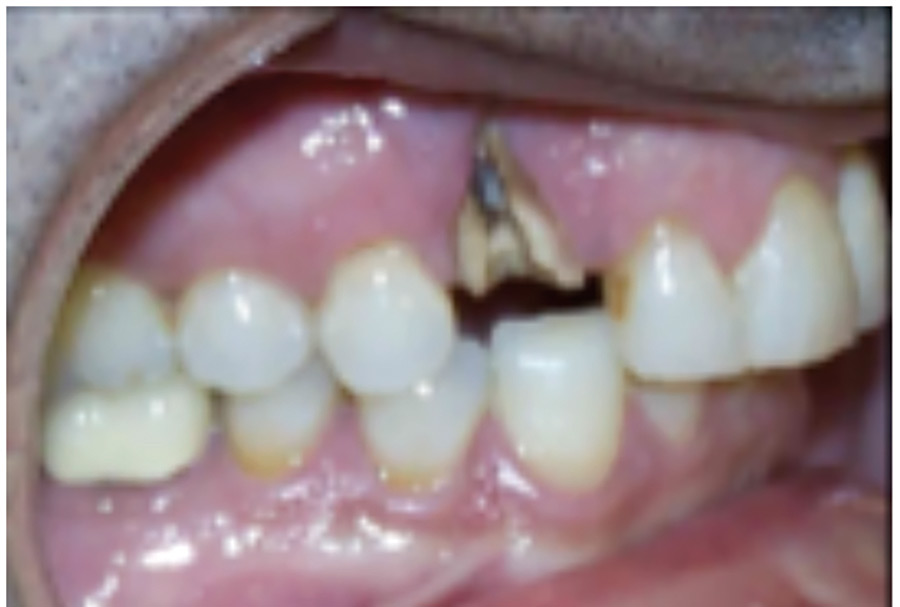
Fig. 16

Fig. 17
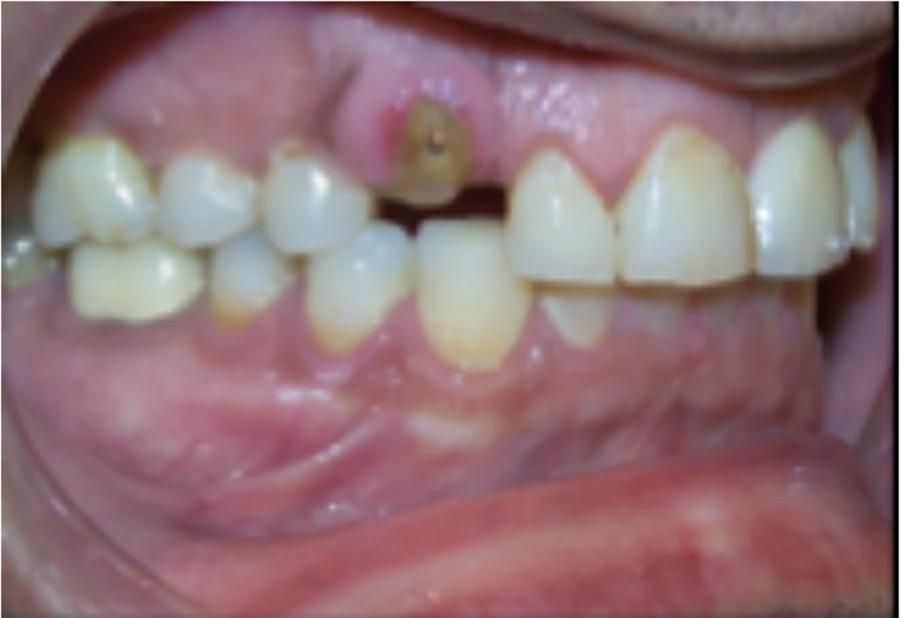
Pre-prosthetic goal 6: Implant site preparation
Congenitally absent teeth pose a unique problem: on one hand one wants to maintain the primary tooth to maintain the bone, but often these teeth become ankylosed. Once a primary tooth is determined to be ankylosed, an orthodontist should make an evaluation about the remaining facial growth. If there is a significant vertical facial growth remaining, the ankylosed tooth should be extracted to prevent a larger defect from forming.5 If a primary tooth (without a successor) is ankylosed but little facial growth remains, the primary tooth may remain in place.
Orthodontics can help prepare a site for implants in the following ways:
1. Open or close space so it is the appropriate size for an implant- such as in Pre-Prosthetic Goal 1. This can be done with braces or aligners as was demonstrated by the examples discussed.
2. Selective extraction of primary teeth so that the adult tooth can erupt into a strategic position.6 If an adult tooth erupts into an edentulous site and then is later moved, the ridge resorbs less than one per cent in four years.7 This significantly decreases the chance that the patient will need a bone graft in that area. See example below. If teeth need to be moved a large distance, braces are the preferred appliance.
3. Fine detailing of bite and root divergence prior to implant placement, if a tooth was recently lost. This can be done with braces or aligners.
The example above demonstrates a patient with congenitally missing teeth where orthodontics was used to strategically develop the site for a future implant.
Fig. 18

Fig. 19

Fig. 20

at 12.
Summary
Orthodontics is an important part of the treatment planning sequence to ensure an optimal result for patients, in many pre-prosthetic circumstances. Depending on the clinical situation, fixed appliances or aligners may be used, and each has its advantages and disadvantages. Since many adult patients are esthetically conscious, it is possible to use sectional appliances or a combination of appliances to achieve the desired results.
References
- Lee, R., Hwang, S., Lim, H. Cha, JY., Kim, KH., Chung, C.J. “Treatment satisfaction and its influencing factors among adult orthodontic patients.” Am J Orthod Dent Orthop. 153 (6), 808-817, 2018.
- Kokich, V.G., Spear F.M. “Guidelines for Managing the Orthodontic Restorative Patient.” Semin Orthod: (3) 3-20, 1997.
- Seixas MR, Costa-Pinto RA, Araújo TM. “Gingival esthetics: An orthodontic and periodontal approach.” Dental Press J Orthod. 17(5):190-201, 2012.
- Alsahhaf, A., Att, W. “Orthodontic extrusion for pre-implant site enhancement: Principles and clinical guidelines.” Jour of Prosthod Research. 60 (3), 145-155, 2016.
- Kokich Jr. V. “Early Management of Congenitally Missing Teeth.” Semin Orthod: (11) 146-151, 2005.
- Sharma, P.K., Sharma, P. “Interdisciplinary management of congenitally absent maxillary lateral incisors: Orthodontic/prosthodontic perspectives.” Sem in Orthod: 21 (1), 27-37, 2015.
- Spear F.M., Mathews D.M., Kokich V.G. “Interdisciplinary Management of Single Tooth Implants.” Semin Orthod: (3), 45-72, 1997.
About the Author
 Dr. Tracey J. Hendler is an orthodontist in private practice in Toronto, Ontario. Her office Forest Hill Orthodontics, that she shares with Dr. Bruno Vendittelli, is located at 72 St. Clair Ave W, Toronto, Ontario, M4V 1M7. She can be reached at drh@foresthillortho.com.
Dr. Tracey J. Hendler is an orthodontist in private practice in Toronto, Ontario. Her office Forest Hill Orthodontics, that she shares with Dr. Bruno Vendittelli, is located at 72 St. Clair Ave W, Toronto, Ontario, M4V 1M7. She can be reached at drh@foresthillortho.com.
Follow the Oral Health Group on Facebook, Instagram, Twitter and LinkedIn for the latest updates on news, clinical articles, practice management and more!







